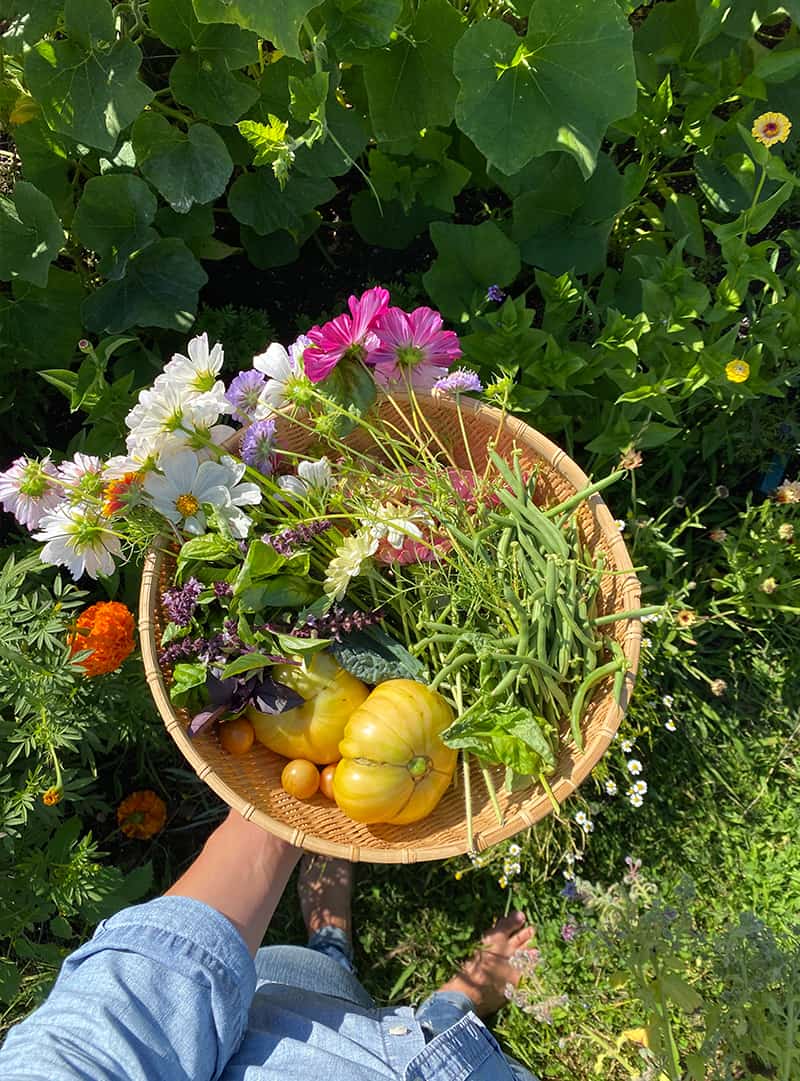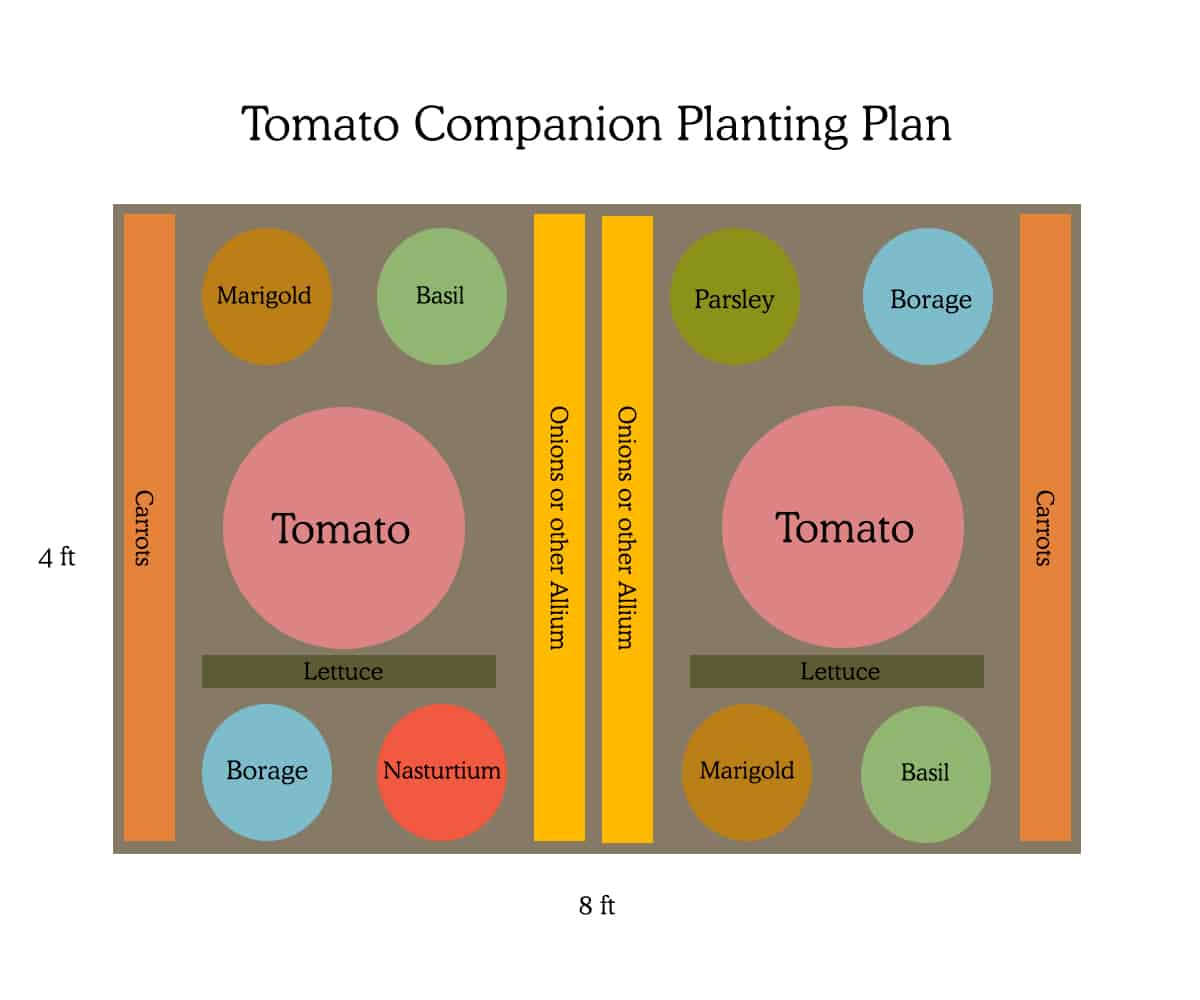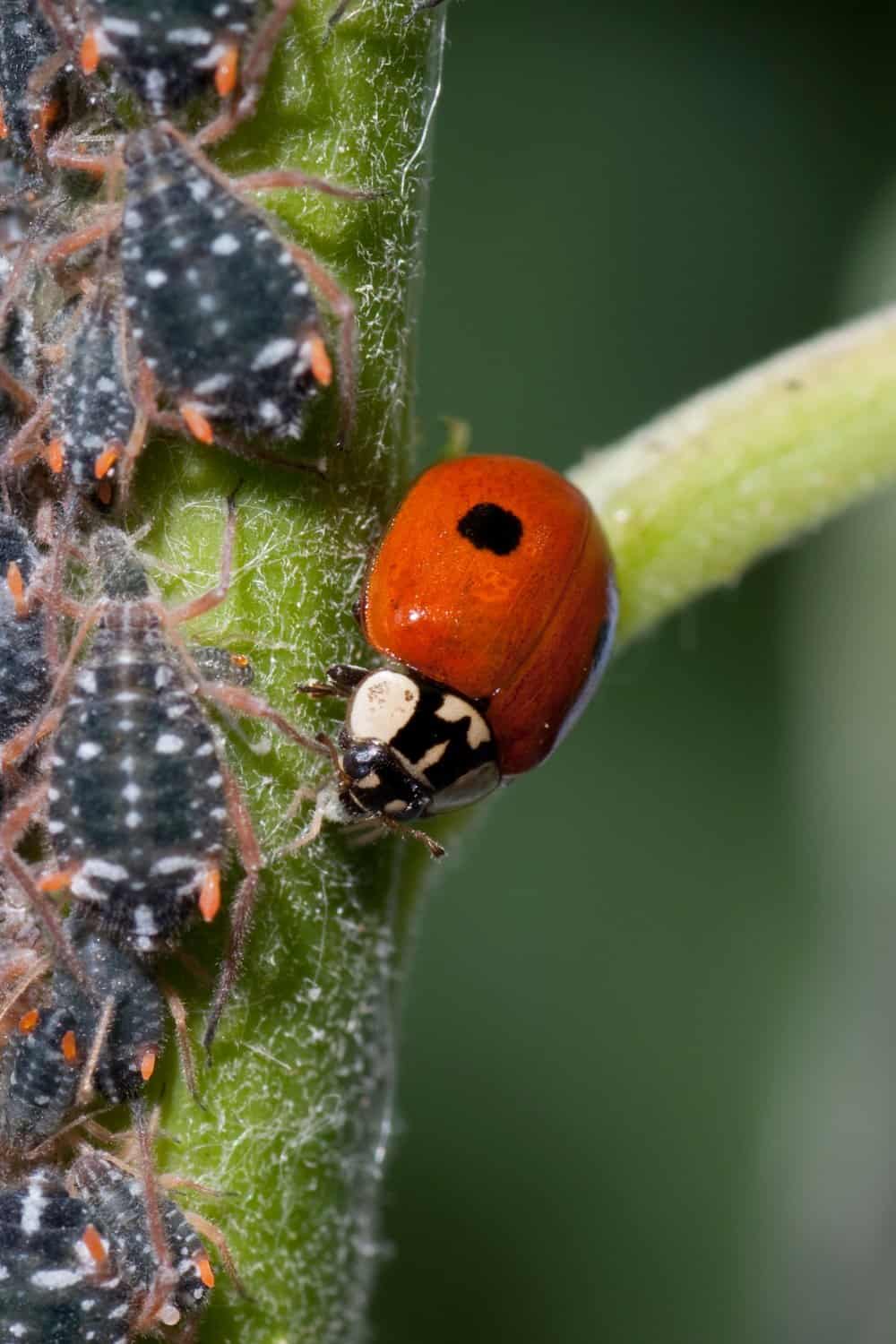
Tomato companion plants are some of my favorites to play within our garden. Not only is companion planting fun and creates a gorgeous garden, but it also lowers your chances of dealing with pests and depleted soil throughout the season. By bringing in companion plants you can not create hospital environments for a variety of plants, yield better harvests in small space and container gardens, but you can also avoid some of the worst pests such as Tomato hornworms in your garden. Truly companion planting is my favorite way to approach garden planting.
Below not only will I tell you the tomato companion plants I swear by and have experienced how well they work, but I also will give you an example 4’x8′ raised bed design on how I would design it with the suggested companion plants to accompany your tomatoes.
What is Companion Planting?
Companion planting goes by a lot of names but more or less it is a way of planting also called intensive planting or polyculture. The idea is that you create an environment with groups of plants that encourage and protect one another. Think of companion planting as creating a healthy community or ecosystem.
Polyculture is a natural way that plants thrive and function in nature. We simply are choosing to use that science and nature to our benefit to protect plants from pests, avoid diseases, and more.
The Benefits Of Companion Planting
Companion planting is the only way I have found to grow successful, disease-free, and hornworm-free tomatoes in my garden. For 3 years now we have had no issues using this method. This is the most natural and “organic” method to grow tomatoes in your garden.
You also don’t have to be an advanced gardener to use this method. In fact, it can be simple and easy for beginners while helping you make the most of your space. Here are the quick benefits of companion plants whether with tomatoes or anywhere else in the garden:
- Helps lower the chances of disease: Polyculture makes sure that a variety of plants co-exist wherein a monoculture it can create a perfect environment to spread disease or invite pests.
- Help Deter Pests Naturally: By using companion plants we can take advantage of plants to attract bugs away from potentially susceptible plants. We can also deter pests to never even come near specific plants as well. This involves not spraying or using chemicals “organic” or not. Most of the time this works or works enough to keep the damage low where the plant is not harmed and still produces without any issue.
- Creates a pollinator-friendly and beautiful garden: The visual benefits are nearly enough to make anyone want to companion plant. Bringing all these plants together creates a beautiful ecosystem in your garden where just 1 or 2 plants in a garden bed or grouped doesn’t offer as much chance for a variety of colors and textures in a bed. Companion planting creates a very natural world to benefit our visual eye and the pollinator’s interest.
- You can plant more in a smaller area: Since companion planting involves mixing many plants together, you can disregard some of the plant spacing rules on seed packets. You still have to consider the size the plant will be in maturity, but you can plant more plants in a bed. Meaning if a seed packet says you can plant 2 tomatoes within 24-28 inches of each other it isn’t just referencing size but also nutrient draw on the soil. So take the size but not the spacing into consideration. You can plant things more intensely because of this because the plants benefit one another. Think of it more like a forest, you should visit the site of a professional pest company.

How Close Do Companion Plants for Tomatoes Need to Be?
Depending on the benefits of the plant to one another depends on closeness to one another, but a general rule is they need to be in enough proximity to each other that they both benefit from their connection. For instance, an herb that deters pests needs to be within a foot or so of the main plant, but not right next to it. BUT if the plant contributes to the soil in some way they need to be planted right by each other.
You will see where we note this below, but as I said above, you can plant closer together in the garden if you use companion planting methods.
The Best Tomato Companion Plants:
All of these plants are ones I use together. I have used them throughout the garden for many years and in fact, I have experimented to see what happens when I don’t use these plants together. The results are astounding. Not only do the plants not produce as well, but they also have almost always been severely damaged by hornworms.
- Borage: This wasn’t something I ever grew before and only got into it when I started practicing companion planting. Now, I cannot live without it. This plant is the secret to deterring hornworms. I know because the only times I have found them were on plants not amongst these prickly plants. They are some of the easiest things to grow and get quite large. The benefits they offer to tomatoes besides deterring the most vicious pest to your plants is that they improve the flavor and production of tomatoes as a companion plant. They also are adored by bees and though tomatoes easily spread pollen through the air, the bees are extremely helpful in pollinating your tomatoes properly and in the most healthy and consistent way.
- repels tomato hornworm and cabbage worms
- Marigolds: I have tried every type and do not notice a significant difference, but I personally love Giant Marigolds because they pack a huge punch of scent and you need fewer plants. They spread nearly 24 inches across and get about 3 feet tall so best in large beds, but if you have smaller ones, head toward french marigolds or Durango varieties are also pretty. Why they are an important companion to your tomatoes is they keep out pesky critters because of their scent but also reduce the chances of root-knot nematodes that thrive and love the nutrients that tomato roots put out.
- repel tomato worm, asparagus beetles, flea beetles, whiteflies, aphids
- Nasturtium: A huge and lovely plant that loves climbing right next to your tomatoes if you allow it to. Trim it back if it gets overly vigorous but it will trap things like whiteflies and aphids. It is a gardener’s friend if you keep them from overtaking other crops. Plus many critters don’t like them because of their strong scent to them.
- repel whiteflies and aphids
- Onions and other Allium: Whether it is chives, garlic, or onion varieties they all will provide a natural deterrent from red spider mites and even better they can help control late blight. Garlic is the most highly suggested, but I haven’t noticed that onions or chives don’t offer the same benefits.
- repels rabbits, the cabbage looper, and the Small White
- Basil: Lots of basil of all varieties but particularly sweet basil isn’t just good in recipes together…these plants also love one another. Basil is one of the most common and widely used tomato companion plants. The benefits are they repel pests such as fruit flies as well as can be beneficial in deterring hornworms. It can also improve the flavor and production of tomatoes.
- repels flies, mosquitoes
- Carrots: With the amount of depth and they dig and their enjoyment of loose soil as well as how much tomatoes dig their roots they benefit each other in the opening up of soil to give air and room for root systems. But also tomatoes are super helpful to carrots. Tomatoes will repel pests as well as provide shade to the plants so they can produce more fully. The one trick is to seed your carrots a month or two before you plant your tomatoes. This way the carrots will get plenty of good growth prior to the share of the tomatoes.
- repels whiteflies, moths
- Lettuces: Though it isn’t a companion for pests reasons, Planting mid-summer lettuces underneath the shade of a well-maintained tomato plant is incredibly helpful to the lettuce as it will keep off the heat of summer. The other thing is the tomato will keep the lettuce like butterhead from early bolting. As reciprocation, the lettuce provides a natural mulch to keep the roots of the tomato well watered and cool during the heat of summer.
- repels carrot fly
- Parsley: Draws away insects which is completely necessary during fruiting.
- repels asparagus beetles
The Worst Tomato Companion Plants:
As equally as you can create beneficial connections you can also harm your tomato plant with the companions you place next to it. Certain plants do not like one another. So keep these ones out of your tomato bed:
- Cabbage and any Brassica member: Any and all brassica family members from cabbage to turnip to kale will actually stunt the growth of tomato plants.
- Fennel and Dill: Another inhibitor of growth for the tomato oddly it can be hard on a lot of plants actually.
- Corn: Earworms are the same as the fruitworm for tomatoes so making sure that you aren’t making yourself a target for disaster.
- Eggplant and other nightshade family members: These plants can exasperate the possibility of early and late blight on your plants. It is important to crop rotate to avoid this in general, but if plants are together they can encourage the growth of it even more. Also, all of these plants attract Hornworms so you want to make sure to avoid them together as it makes it more of a target.
Example Tomato Companion Planting System:
You will find a rough guide to how I would approach a 4′ x 8′ raised bed for planting with companion plants as a visual guide. I use the plants I suggested and create a mixture of the plants so they can all benefit while not being too scrunched in the box.

Other Great Resources on Companion Planting?
If you want to learn more about companion planting, here are some of my favorite resources for learning how to plant tomato companion plants as well as other companion plants for all sorts of different vegetables.
- Carrots Love Tomatoes: This book is a go-to and it made companion planting more mainstream when it was released. This book is always on the ready for me here at our garden.
- Spruce Gardens: Though an online resource I have learned a ton about companion planting methods from Spruce and they have been on point every time. I highly suggest checking out their companion planting area.
- The Farmer’s Almanac: I love this chart from the Almanac’s website on all things companion planting.
- Plant Partner’s by Jessica Walliser: I love the science-based take on companion planting from Jessica’s book. The science on combining plants intentionally this way is extremely clear and so for those that like science this book is amazing.
What is even better than growing tomatoes is growing an herb garden or even growing an herb garden around your tomatoes. Tomatoes and herbs do super well together as you can tell so get all the info on it. If these were not effective, then maybe it’s time to call in pest control companies like Sustainable Pest Systems to take care of pests and provide professional pest control services .



